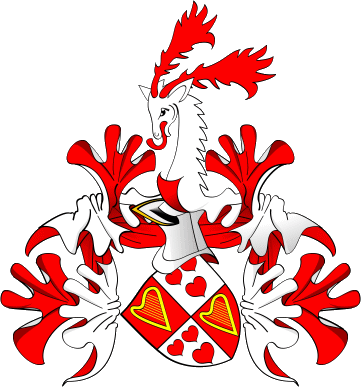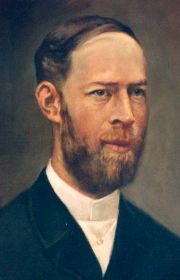

Heinrich Rudolf Hertz (1857-1894): Radio waves (1888).
Gustav Ludwig Hertz (1887-1975): Nobel 1925.
Carl Hellmuth Hertz (1920-1990): Medical ultrasonography.
[
The above copyrighted picture is reproduced
here by permission: © 2008
Jochen Wilke. ]
Quarterly. [1 & 4] Gules a harp Or. [2 & 3] Argent, three hearts Gules.
Crest: A fallow stag's head Argent, armed and langued Gules.
Mantling: Gules and Argent,
At least four members of the Hertz family are noteworthy scientists:
1.
Heinrich Rudolf Hertz (1857-1894)
founded the science of contact
mechanics in 1882,
discovered the photoelectric effect in 1887 and
demonstrated the existence of electromagnetic waves in 1888.
In 1902, Lenard would observe that the
photoelectric effect doesn't occur at all, for a given metal, unless light exceeds a certain
threshold of frenquency (irrespective of light intensity).
That paved the way for the epoch-making discovery of the photon by
Einstein in 1905, which provides the final physical explanation
for the blackbody specttrum formula
discovered by Planck in 1900.
The SI unit of frequency
(symbol Hz) was formally named after Heinrich Hertz, in 1960
(it had been introduced in 1930 to replace the former cps = cycle per second).
2.
Gustav Ludwig Hertz (1887-1975).
Nobel 1925.
Nephew of Heinrich.
3.
Hellmuth Hertz (1920-1990).
Pioneer of medical
ultrasonography. Son of Gustav.
4.
Hans Hertz
(born on 1955-08-22 in Lund, Sweden).
Son of Hellmuth and grandson of Gustav.
Hans Martin Hertz was elected ro the
Royal
Swedish Academy of Sciences in 2007 and to the
Royal
Swedish Academy of Engineering Sciences in 2008.



